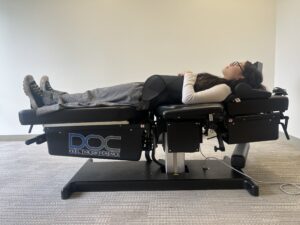The work of a joint is to connect two or more body bones to facilitate motion. In our spine, facet joints are the joints that connect two or more vertebrae. Like any other joints in the body, facet joints allow effortless motion in the intervertebral disc. This functionality caters to the stability of each motion segment. Unfortunately, because of age or any accident, a person can get damage in his facet joints which leads to facet joint syndrome.
The Facets are located in the neck, upper back, and lower back. They exist in pairs, one on each side of the spine and at each level of the spine. They are essentially synovial joints, similar to the joints we have at the knuckles and the knees.
If it’s acute, it can be like a sharp shooting pain. If it is more chronic, it can tend to present duller and achy, sometimes paired or coupled with muscle spasms.
Causes of Facet joint syndrome
The Facet joints are one of the most overlooked when it comes to back pain. About 15% to 45% of all back pain originates from these facet joints. There are millions of people with back pain who have inflamed facet joints.
The leading cause of facet joint syndrome depends on the affected region of the spine. For instance, if you are experiencing facet joint pain in your lower back, it is probably because of your age.
With age, our body structure which supports the spine, like the intervertebral disc and facet joints, gets wear and tear due to strain and physical activity. In addition, the intervertebral disc comprises water, and our growing age affects disc hydration, ultimately reducing the disc height. Such things lead to lower back pain.
Some other posts we think you’ll find useful:
Symptoms of the Facet Joint Syndrome
Well, the facet joint pain usually presents as more localized pain versus radiating pain or traveling pain. So you can have localized pain in the neck or the lower back. When they get bad enough, facet joint pain can radiate to other parts.
For instance, if facet joints in the neck are compromised, the pain will radiate into the upper back and the arm. Similarly, if facet joints in the lower back are experiencing the pain, you may experience pain down into the glutes and the high hamstring area. Facet joints can present as pain, but they can also present as muscle spasms and just dull and achy pain in general.
Besides, joint pain can worsen because of specific movements such as forward bending and twisting motions.
Let’s know more about the symptoms of facet joint syndrome as per the affected joint.
Cervical Facet Joint Syndrome
Cervical Facet Joint Syndrome causes neck and shoulder pain, which will restrict motion. Thus patient will find it difficult to rotate the head with ease. Facet syndrome in the cervical spine may also lead to a headache.
Thoracic Facet Joint Syndrome
This syndrome causes pain in the mid-back. In addition, this restricts the patient from several body movements such that a patient may need to move their entire body to the left or right to see in that particular direction.
Lumbar Facet Joint Syndrome
This causes pain in the lower back. Patients will feel pain in the lower back or sometimes in the buttocks. But the pain will never go below the knees. Such inflammation causes stiffness and makes it difficult to stand straight and get up from the chair.
Which is the most common facet joint syndrome?
Degenerative Joint Syndrome is the most common one. Around 60% of adults over the age of 65 have some sort of the arthritic change in their necks. And over 90% of adults over the age of 65 have some kind of degenerative or arthritic changes in their lower back. Now the facet joints and the discs work together.
So when the facet joint is compromised, the discs also tend to get involved, causing a duel, and both of them mostly feed off of each other and cause you pain. Therefore, through chiropractic treatment, we will address both, the disc and the facet joint when working with a patient with some of these symptoms.
Diagnosis of Facet Joint Syndrome
Your chiropractor will feel tenderness around the facet joint and do palpation or push into the spot to diagnose the condition.
When you visit the doctor’s clinic, he will check your medical history and do some physical and neurological exams. The physical test includes bending, walking, or twisting your body. This will help the expert to know the exact pain point in your back. The neurological examination checks your nervous system and may test your reflexes and responses.
While neurological tests and physical examination will inform the doctor about your condition, a diagnostic injection is necessary to confirm the facet joint syndrome. In such injections, the doctor will give local anesthesia to the suspected joint pain site. A decrease in pain immediately after injection shows that the doctor can know the source of pain and can plan further treatment accordingly.
Sometimes your doctor may observe the inflammation area and then perform other tests that diagnostically could be x-rays that could look at the joint spacing and if there’s any inflammation around that facet joint. There is also a slew of orthopedic examinations that can be done during treatment and consultation. The most expert way to diagnose facet syndrome is through imaging, the orthopedic test, and of course, touch and feel.
Is it possible to repair facet joints?
That’s a complicated question because once a facet joint has degenerated or deteriorated, doctors cannot re-grow the bones, but they can manage it pretty well. Of course, if you’re catching your facet syndrome a little bit on the earlier end of things, your specialist can start to stop things in their tracks and begin to reverse the process through good treatment.
Treatments for facet joint syndrome
After confirming your facet joint syndrome, your doctor will probably start with nonsurgical treatments. This may include anti-inflammatory medications and physical exercise. Some exercises give strength to your lower back and help prevent facet syndrome. But there are some holistic ways to treat this syndrome. For example, your specialist may go with hot and cold therapy based on acute or chronic pain to cure the syndrome.
If your facet joint syndrome is very new and acute and there’s inflammation, we may start with some cold or Cryotherapy followed by heat therapy and then contrast treatment. At our San Francisco clinic, we utilize cold and hot therapy and other therapies such as Chiropractic and Acupuncture. One big thing to understand when it comes to facet joint pain is that it can sometimes pop up for numerous reasons. For example, when you may go to pick up something heavy off the ground, or sometimes it’s random; you just kind of wake up with it or maybe sleep incorrectly. So we’ve seen these conditions pop up for many different reasons. But regardless of the reason, we treat all types of facet joint syndrome at our San Francisco clinic here at Truspine.
One thing that has worked for our patients is getting them into a supportive brace. Wearing a supportive brace between flare-ups can help reduce the discomfort that comes with facet syndrome. Pairing that supportive brace with treatment or therapy at our clinic can help. So Chiropractic treatment can help to take pressure off the facet joint syndrome through a technique called Spinal manipulation therapy or adjustments. Adjustments are quick forces into the joint to help to decompress the joint and reduce inflammation. We do offer Chiropractic therapy here at our San Francisco clinic.
Another beneficial therapy is Acupuncture. Acupuncture can be beneficial in helping to ease the tension or pinching of the nerves to help relax the muscles around the nerve, especially if your facet syndrome presents with any radiating or traveling pain. Other than that, we love to pair our Chiropractic and Acupuncture care with exercises to ensure that once we get rid of your facet syndrome, it stays away and doesn’t come back. So strengthening the muscles around the facet joint is much more helpful.
To experience the benefits of acupuncture, schedule an initial consultation for evaluation and first treatment.
Can massage therapy help facet joint syndrome?
The short answer is no. Facet joints are deep, and massage therapy is more superficial.
Can massage help in any aiding with the recovery process?
Yes, once the acute phase has been completed, then massage therapy can aid in helping you recover from facet joint syndrome.
How long does facet joint syndrome take to heal?
It depends on how long you’ve had your pain and many other factors. But typically, we can resolve the facet joint syndrome at our San Francisco clinic in about four to six weeks.
Can facet joint syndrome or pain heal itself?
The body is self-healing, but sometimes it needs a push in the right direction.
And we believe our chiropractic care paired with Acupuncture and other therapies can help you on your way.
What are the best exercises for facet joint syndrome?
The top three exercises for facet joint syndrome are planks, child’s pose, and cat-cow stretch.
What is the best sleeping position for facet joint syndrome?
We typically recommend patients suffering from facet joint syndrome sleep on their side with a pillow between their knees and try to keep their body in a neutral position as possible. The proper pillow and mattress are also recommended.
Conclusion
The best medications for facet joint syndrome are NSAIDs, Acetaminophen, and a type of muscle relaxer. However, we highly recommend seeking professional help before attempting to try one of these medications for your pain.
Are you suffering from back pain? Does it become a part of your life? Do you know 60% of people suffer from back pain, which can be Facet joint inflammation? Give us a call at Truespine, our San Francisco clinic, to get correctly diagnosed.
Can Chiropractic Care help cure your facet syndrome? We’ve cured plenty of facet joint syndrome victims at our clinic. To get to the root cause of pain and discomfort, schedule an initial consultation, including a comprehensive evaluation and first treatment.



